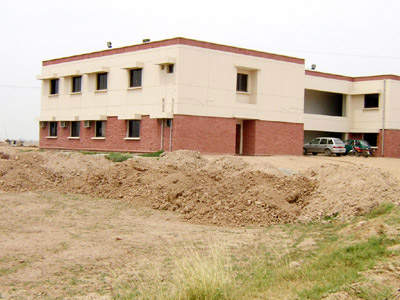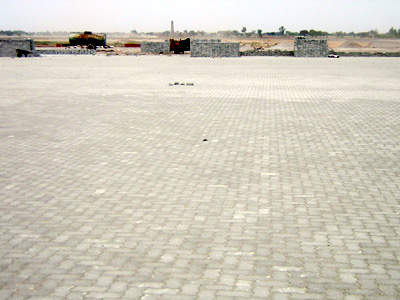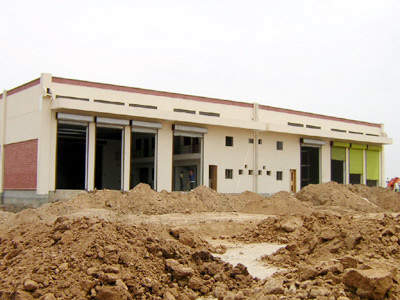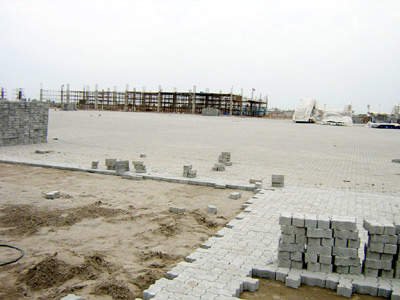Sialkot International Airport is currently being constructed on a 1,050ac site situated 14km west of Sialkot in Pakistan.
The site has been well chosen as it has excellent transport infrastructure with existing road links to Wazirabad, Gujrat, Gujranwala, Narowal, Sialkot City, Sialkot Export Processing Zone and Sialkot Dry Port.
The airport has been situated on this site to cater to the needs of the industrial triangle of Sialkot, Gujranwala and Gujrat and Mirpur Azad Kashmir. The Pakistan Government have hopes that the airport will bring a greater prosperity to the area and
contribute to socio-economic development in the region.
An efficient cargo hub in the area has long been required as the area is a major export area in Pakistan for surgical instruments, leather goods, musical instruments, textiles and sports equipment.
CONSTRUCTION FINANCE
Construction of the airport was first approved in February 2001 by the President of Pakistan, Chief Executive General Pervez Musharraf.
This was followed by the establishment of a management company to build and operate (build, own and operate) the airport, Sialkot International Airport Limited (SIAL).
SIAL is a company with 223 directors, each of which has invested Rs5m of capital in the project as the primary investment. Each of the directors was invited to take part in the project because of their previous experience of running sizeable and
successful enterprises.
In February 2001, a Memorandum of Understanding (MoU) was signed between Sialkot Chamber of Commerce & Industry and the Civil Aviation Authority of Pakistan with the approval of Ministry of Defence for the construction of Sialkot International
Airport.
This was the beginning. The project was expected to cost Rs1,500m along with Rs230m (provided by the Government of Pakistan) to obtain the 1,050ac site for the construction. So far the total expenditure has exceeded Rs2,320m.
CHENAB RIVER BRIDGE
The Shahbazpur Bridge on the river Chenab will be a major boost to the airport by providing easy access to the entire region.
The new bridge started in early 2005 is situated about 10km away from Sialkot International Airport and when completed in late 2007 will reduce the distance between the cities located on either side of the river.
It will provide a new gateway for the people of Gujrat, Kharian, Lalamusa, Jhelum and Azad Kashmir. On completion, the distance from Sialkot to Gujrat will be reduced from 56km to 38 km. The bridge will be completed at an estimated cost of Rs70m.
MASTERPLAN FOR THE NEW AIRPORT
In order to construct the new airport SIAL contracted NESPAK to develop the master plan and after much deliberation and consultation over two years a fully integrated plan was finalised and approved by the Civil Aviation Authority.
The Airport Master Plan envisaged a phased development of facilities. Construction at the airport began with the runway in January 2003.
PHASE ONE CONSTRUCTION
The phase one construction included the required essential infrastructure to get the airport functioning. This included:
Runway: 3,600m long, 45m wide with 7.5m-wide shoulders on either side corresponding to International Civil Aviation Organisation Category 4E.
Link taxiway: 263m long, 23m wide with 10.5m shoulders.
Apron: for passenger and cargo, 45,000m² area, a combination of flexible and rigid pavements, nose-in parking for four wide-bodied aircraft at a time or three Airbuses plus three F-27 aircraft at a time.
ATC tower: complete facilities and equipment for air traffic communications and control.
Approach road: 1km-long, four-lane divided carriageway with ROW of 40m.
FCR facility: as per ICAO Category 9 airport requirements.
Link roads: connecting the airport to Sialkot and routes to all cities in the area.
Infrastructure: chain link fencing along airport perimeter, security arrangements, barriers, watchtowers, perimeter track and drainage network.
Land side facilities: passengers terminal building, cargo complex, passenger car parking and cargo truck parking area, ATC tower, FCR building, mosque, administration block and ASF camp.
Navigational aids: PAPIS, VOR, DME, ILS and TDME.
Utilities: water supply, sewerage, drainage, solid waste disposal, telecommunications, power and gas.
Other services: fuel farm, aircraft ground maintenance services, catering and other related services through concessions to private parties.
CONSTRUCTION PROGRESS
In March 2005, the airport was opened for test flights and limited cargo. The first plane landed on the newly constructed runway (built to handle a fully loaded Boeing 747 – the future of the airport will involve heavy cargo aircraft). Work on the
runway is still not complete but is expected to be by mid 2006.
The air traffic control tower, the cargo terminal and the apron are in advanced stages of construction and are expected to be completed by mid to late 2006. Work on the passenger terminal has commenced and is expected to be completed by the third
quarter of 2007.
PROJECTED USAGE
The airport operating company SIAL have projected 143,000 passengers per year at the opening of the airport in 2007 and this increasing to 250,000 passengers per year by 2024. At the same time the cargo revenue is projected to start at Rs43m in 2007
and will rise to Rs161m by 2024.
Estimated cargo tonnage at the time of opening is expected to be 24,000t and by the end of 2012 about 53,000t of cargo will be lifted from the airport per year. Pakistan State Oil has already signed an agreement (late 2004) with SIAL for the
establishment of a retail fuel farm concession at the airport.
NAVIGATIONAL EQUIPMENT FOR THE AIRPORT
M/s Interscan Navigation System (PTY) Ltd of Sydney, Australia is due to supply and install ATC and NAVAIDS equipment for the airport on a turnkey basis.
The contract will involve the supply and installation of ILS, DVOR, DME and VHF equipment at the airport allowing it to conform to the operational, navigational and landing requirements of all types of modern aircraft.
A technical team from SIAL and CAA have visited both Australia and Norway for hands-on training on the equipment.







